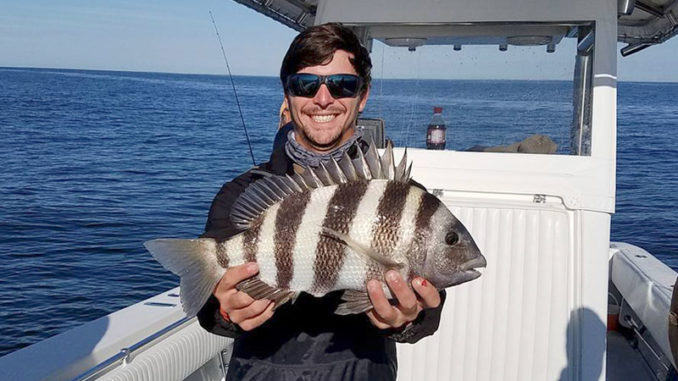
Sheepshead give Carolina anglers a tasty target in February
February can be a brutal month for anglers in the Carolinas, but one fish that is available year-round and bites well during cold weather is sheepshead. They are in our inshore waters as well as around nearshore and offshore reefs this time of year.
Sheepshead have saved many a winter’s day of fishing. Redfish are schooled up by the hundreds in February, but dolphins keep them wary. Speckled trout head to deeper holes and often refuse bait or lures placed in their faces. But dangle a fiddler crab or a piece of oyster in front of a sheepshead, and that bait is going to get gobbled up.
“I really like fishing for sheepshead this time of year because I concentrate more on them,” said John Long of East Columbia (S.C.) Sport Shop, who has a part-time residence on South Carolina’s St. Helena Island. “In the spring, summer, and fall, I think most anglers try to do too much. They want to catch redfish, speckled trout, black drum and sheepshead. I know I’m guilty of it. But to get serious about sheepshead, you’ve got to fish specifically for them. It’s a different technique than all the others.”
Long spends most of his February fishing time in the inshore waters near Beaufort, S.C. Like areas all along the coasts of both Carolinas, the waters are full of wooden docks with pilings, rock walls, wooden walls, bridge pilings, culverts, jetties and groins. Sheepshead stack up on these types of structure.
With the Lowcountry’s big tidal swings, Long has also found numerous sheepshead locales that are not evident at high tide.
“If you spend enough time just riding around and looking at low tide, you’ll find spots with sunken cinder blocks and other debris that attract sheepshead,” he said. “Even structure that doesn’t sit high off the bottom will attract them.”
Carolina rigs
Long catches sheepshead with a simple Carolina rig, fishing vertically above or beside structure. He prefers a stiff rod for driving the hook home.
“You don’t want any slack in the line,” he said. “You want to maintain constant contact with your bait. They bite quickly, and if you don’t set the hook immediately, you’ll miss it every time.”
While Long prefers fiddler crabs as his primary sheepshead bait most of the year, he often uses the meat from clams or oysters in the winter. Fiddler crabs are usually tough to find in February. He said the few he sometimes sees are not worth the bother of stomping through the mud.
“One of the best fishing tools you can have with you this time of year is a good set of channel lock pliers. They make it easy to break open clams and oysters to get the meat out. That meat makes some great sheepshead bait,” he said.
Tight-line option
While many other sheepshead anglers prefer to keep their lines tight the way Long does, it’s not the only method. Stacy Atkinson, host of Low Country Wildlife TV, learned a different tactic while filming one of his shows.
“It’s a brilliant technique, but I can’t take credit for it. I learned it from a guest on one of my shows,” he said. “Instead of keeping the line tight, you put a fiddler crab on with a very light weight. You toss it into the rocks or other structure, and you let the crab find his own spot to rest. Then you leave enough slack in the line that the crab looks natural. And when a sheepshead grabs it, the line will come tight, and you’ll know to set the hook.”
When using this method, Atkinson said it’s important to hook the fiddler crab without killing it. He suggests running a No. 4, wide-gap hook into one of the crab’s back legs and leaving the barb inside. That does as little damage to the crab as possible, allows it to stay alive, and keeps the barb from getting hung in debris.
Atkinson said boat control is very important when fishing this way. With waves, wind and current constantly pushing the boat, anglers can find themselves in trouble real fast.
“When you’re fishing like this, and so close to a rock jetty, you really need to have one person on the boat doing nothing but manning the trolling motor to keep the boat off the rocks,” he said.


Be the first to comment